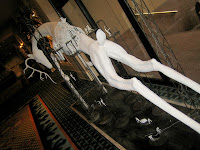It
seems impossible that the solutions to the most pressing problems of humanity
will ever be resolved through debate among scientists, politicians, or the writers
of newspaper editorials. Scientists can look at the same phenomenon; for
example, the Fukushima disaster, and split into opposing groups who see it in
two extremely divergent ways. How is this possible with the same data to work with? It is either a public health catastrophe that has
ruined half of Japan, or it is an event of almost no consequence at all. If
their data and their scientific methods can provide no answers and no way
forward, it may be only artists who can guide us at this point.
I
was reminded of this idea recently when I saw the sculpture The Stag on display in the lobby of the Fairmont Hotel in Dallas. Like all the other busy convention-goers, I walked past a few times
without noticing it. You just don’t expect to find such a stunning work of art
in a hotel lobby.
When I finally shook off my flight fatigue, I was able to pay proper attention to my surroundings. I
took some photos of the sculpture, and found out from the staff that the piece was made by the
hotel’s 2011 artist in residence. (More about the artist, Hobbes Vincent, here.)
The
work immediately told me much of what I've been trying to say for two years about the Fukushima disaster and humanity’s relationship with nature. Artists
are often amused by what observers say their work means, but I’ll at least tell what it said to me.
One
review
I came across described it as “surrealistic sculpture,” but I would add that it
is also absurdist because the sight of the construction crew assembling a
living creature immediately conveys that the idea is preposterous, for we all
know the notion expressed in the poem Trees (only God can make a tree), or the
moral of the tale in Humpty Dumpty. Yet
we forget these simple lessons from our earliest education. It is not hard to
find numerous examples of our pathetic, vain attempts to improve nature or to fix the damage we
inflict on it. We bio-engineer life to make pesticide resistant crops, which
justifies applying more pesticides, which kills the bees that used to pollinate
a neighboring orchard. We justify the existence of the nuclear industry because
we need it to produce the isotopes that will “conquer” cancer. (Do I need to explain
that irony?) There are even grand plans to geo-engineer a fix to climate
change.
The sculpture also reminded me of the contentious line from the 2012 US presidential election, President Obama’s declaration you didn’t build that. It led to a ridiculous false debate, with one side making the obvious point that private enterprises depend on publicly funded institutions in order to succeed, and the other making the point that private enterprises make funding of public institutions possible. They could have just argued whether the chicken or the egg came first, but even then they would have missed the essential point that only God can make a chicken or an egg, or anything that we ultimately derive our prosperity from.
The
sculpture has another interesting layer of recursive meaning, for the
artist himself is, like the construction workers in The Stag, daring to mimic the Creator. But I put the artist in a
separate category from those who make vain attempts to “decontaminate” Japan or
“remediate” the Gulf of Mexico. While industrial accidents offend nature, the
artist’s intention and purpose, and the effect of his work, are a tribute to natural
creation, and they remind humanity of its lost humility.
Trees
I think that
I shall never see
A poem
lovely as a tree.
A tree
whose hungry mouth is prest
Against
the sweet earth's flowing breast;
A tree
that looks at God all day,
And
lifts her leafy arms to pray;
A tree
that may in summer wear
A nest
of robins in her hair;
Upon
whose bosom snow has lain;
Who
intimately lives with rain.
Poems
are made by fools like me,
But only
God can make a tree.
- Joyce
Kilmer (1886–1918)







No comments:
Post a Comment